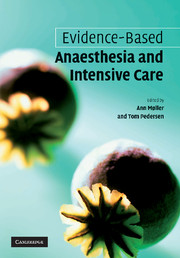Book contents
- Frontmatter
- Contents
- Foreword
- Contributors
- 1 Introducing evidence-based anaesthesia
- 2 How to define the questions
- 3 Developing a search strategy, locating studies and electronic databases
- 4 Retrieving the data
- 5 Critical appraisal and presentation of study details
- 6 Outcomes
- 7 The meta-analysis of a systematic review
- 8 Bias in systematic reviews: considerations when updating your knowledge
- 9 The Cochrane Collaboration and the Cochrane Anaesthesia Review Group
- 10 Integrating clinical practice and evidence: how to learn and teach evidence-based medicine
- 11 Involving patients and consumers in health care and decision-making processes: nothing about us without us
- 12 Evidence-based medicine in the Third World
- 13 Preoperative anaesthesia evaluation
- 14 Regional anaesthesia versus general anaesthesia
- 15 Fluid therapy
- 16 Antiemetics
- 17 Anaesthesia for day-case surgery
- 18 Obstetrical anaesthesia
- 19 Anaesthesia for major abdominal and urological surgery
- 20 Anaesthesia for paediatric surgery
- 21 Anaesthesia for eye, ENT and dental surgery
- 22 Anaesthesia for neurosurgery
- 23 Cardiothoracic anaesthesia and critical care
- 24 Postoperative pain therapy
- 25 Critical care medicine
- 26 Emergency medicine: cardiac arrest management, severe burns, near-drowning and multiple trauma
- Glossary of terms
- Index
19 - Anaesthesia for major abdominal and urological surgery
Published online by Cambridge University Press: 05 September 2009
- Frontmatter
- Contents
- Foreword
- Contributors
- 1 Introducing evidence-based anaesthesia
- 2 How to define the questions
- 3 Developing a search strategy, locating studies and electronic databases
- 4 Retrieving the data
- 5 Critical appraisal and presentation of study details
- 6 Outcomes
- 7 The meta-analysis of a systematic review
- 8 Bias in systematic reviews: considerations when updating your knowledge
- 9 The Cochrane Collaboration and the Cochrane Anaesthesia Review Group
- 10 Integrating clinical practice and evidence: how to learn and teach evidence-based medicine
- 11 Involving patients and consumers in health care and decision-making processes: nothing about us without us
- 12 Evidence-based medicine in the Third World
- 13 Preoperative anaesthesia evaluation
- 14 Regional anaesthesia versus general anaesthesia
- 15 Fluid therapy
- 16 Antiemetics
- 17 Anaesthesia for day-case surgery
- 18 Obstetrical anaesthesia
- 19 Anaesthesia for major abdominal and urological surgery
- 20 Anaesthesia for paediatric surgery
- 21 Anaesthesia for eye, ENT and dental surgery
- 22 Anaesthesia for neurosurgery
- 23 Cardiothoracic anaesthesia and critical care
- 24 Postoperative pain therapy
- 25 Critical care medicine
- 26 Emergency medicine: cardiac arrest management, severe burns, near-drowning and multiple trauma
- Glossary of terms
- Index
Summary
Abstract
There is good evidence that epidural analgesia provides slightly better analgesia when compared with intravenous (IV) opioid regimens; incisional local anaesthetic infiltration has minimal analgesic effectiveness; supplemental IV fluids improve patient comfort, but a restrictive fluid regimen promotes return of gastrointestinal (GI) function; normothermia prevents shivering and wound infection, prophylactic antibiotics prevent infections; heparin and graduated compression stockings reduce thromboembolism; nasogastric drainage has no benefit, but early enteral feeding reduces postoperative infection and hospital stay, and may have other benefits after abdominal surgery. There is inconclusive evidence that supplemental IV fluids improve postoperative nausea and vomiting (PONV), headache and pain; a restrictive fluid regimen reduces postoperative complications and hospital stay; choice of IV fluid has any clinically important effects; optimisation of tissue oxygen delivery with inotrope therapy improves outcome; supplemental oxygen reduces serious complications; nitrous oxide reduces wound infection and pneumonia; and whether or not beta-blockers reduce cardiac mortality.
Major abdominal surgery includes many types of GI, as well as hepatobiliary, aortic, renal, and prostatic surgery. Naturally there are specific anaesthetic considerations inherent in each of these procedures, and some institutions will have unique issues for the anaesthetist to consider, such as innovative surgical techniques or the extent of hospital resources available for the perioperative care of the patient.
Keywords
- Type
- Chapter
- Information
- Evidence-based Anaesthesia and Intensive Care , pp. 223 - 246Publisher: Cambridge University PressPrint publication year: 2006
- 1
- Cited by

